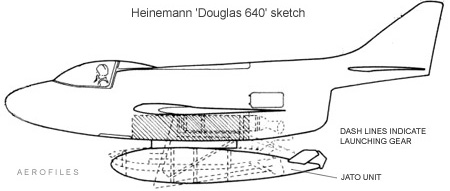
Airplanes Under Water
The idea of submarines carrying an attack airplane has been around for a long time—there were ritual Popular Science magazine covers predicting such marvels and there were experiments around 1920 with the Sperry Messenger miniplane housed on a sub's deck and, later the Loening XSL-2. Then in WW2 the Japanese navy had limited use of such a weapon—while their role was limited more to scouting, one did manage to make the only bombing attack by an airplane on the US mainland*. However, during the Cold War, spurred by reports that the Soviets were experimenting with submarine-launched aircraft, the USN thought it wise to solicit proposals for such technology.

First response came from Douglas designer Edward Heinemann, who offered sketches and data for a fighter to be carried aboard the 1960 nuclear-powered submarine USS Halibut, which could carry four Regulus missiles in an 80-foot bow hangar that could instead accommodate his modified A4D Skyhawk. The turbojet, with a flying boat hull, assigned the model name Douglas 640, would be catapulted from the surfaced sub and recovered by a telescoping crane. With modifications to the sub's hangar, the 640's wings and tail would fold for shipboard stowage.

Although the Navy rejected Heinemann's brainchild, there were other similar proposals, and the USN's Bureau of Aeronautics sponsored the most ambitious one, Project Flying Carpet from Boeing, also based on the Halibut design but much larger in size and scope, and costing about half again as much as a Polaris missile submarine. The concept was a 500-foot-long nuclear-powered submarine-aircraft carrier, designated AN-1, capable of carrying eight aircraft in two large hangars built into its forward hull.

Plane of choice initially was the folding-wing, Mach 1-plus Grumman F11F, supplemented with a folding tail and a large rocket booster for launching from a catapult that was, once the pilot climbed in, elevated to a vertical position.

BuAero went as far as conducting feasibility studies on weight, stability, and equilibrium using an F11F stowed in one of the USS Grayback's two Regulus missile hangars faired into its forward superstructure. The ultimate plan was to replace the F11F with a Mach 3 aircraft that could either land aboard the sub using a hook-and-cable arresting method (the WW2 Brodie system revived?) or be retrieved by a crane if it set down at sea.

A subsequent AN-2 design followed which would use eight VTOL aircraft carried in vertical hangars on deck. Boeing estimated a launch of four VTOL aircraft in about five minutes of surfacing and eight aircraft in about nine minutes, and that even under the most adverse sea conditions the launch time for all eight aircraft would be 18 minutes.

Although proposals continued to arrive from other sources, the Navy finally abandoned the novel idea for several reasons—bureaucratic opposition to a ship developed by BuAero people, general unfamiliarity with submarine-based aircraft, and the potential for a shortage of higher-priority torpedo subs and Polaris missile subs. Eventually long-range bombers, cruise missiles, and UAVs all but eliminated any need for an underwater aircraft carrier.
*In 1942 the Japanese submarine I-25 twice launched a Yokosuka Type 0 monoplane from a position off Cape Blanco, Oregon, on incendiary bombing raids to ignite forest fires. Both times the aircraft flew about 50 miles inland and dropped incendiaries but there were neither fires nor casualties.
|

